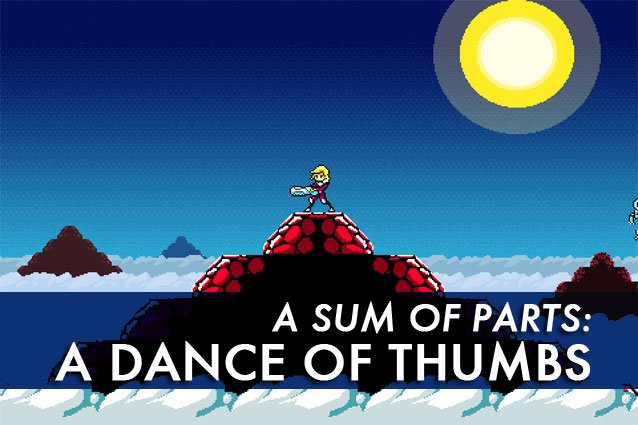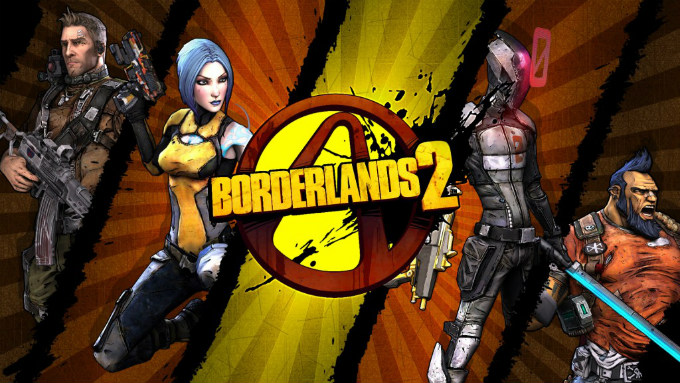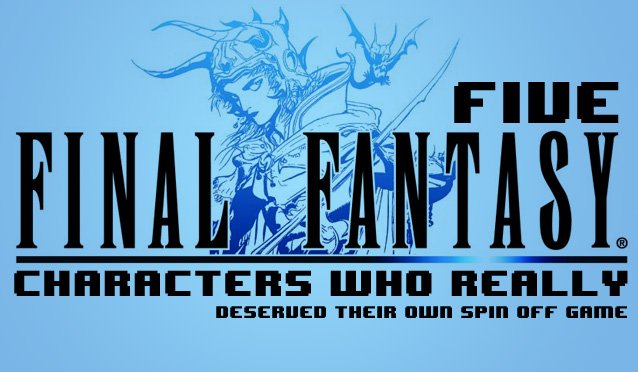


I used to own this really dodgy television. If anyone in our house used the washing machine, two rooms away, the television would intermittently lose its signal. Halfway through playing a game, it would flash a bright blue for seconds at time. All I could do was press pause and wait for the image to come back. Once this happened while I was struggling against one of the more difficult levels of Super meat Boy. I had been playing this one level for well over an hour; I had the first three-quarters of the stage perfected down to a pixel, but I was still hitting a wall (well, more specifically, I was missing a wall) towards the end. On one attempt, the washing machine clicked over to spin dry, and the screen of my television went blue less than a second after I started. But I didn’t pause the game; I didn’t stop moving. My thumbs just kept going. I tapped the jump button for various lengths of time, and I nudged the left analog stick back and forward. When the picture came back, I was still alive; muscle memory and my thumbs had moved Meat Boy through half a stage without my conscious mind contributing anything. Somewhere deep beneath my conscious thought, my body knew exactly what muscles to twitch to get Meat Boy across those challenges, so ingrained were my movements through that level.
To some degree, this happens in all videogame play. For the competent player, any game requires a certain amount of unconscious muscle memory. It’s something I’ve always found fascinating. Sometimes I will try to hold a controller in a way that I can see my hand in my peripheral vision even while I am focusing on the screen. It fascinates me, the things my own hands do, seemingly separate from any instructions my mind is consciously sending to them. It’s an integral area of gameplay we often ignore—an area we are often encouraged to ignore: what our body is actually, physically doing with a piece of hardware to make our virtual bodies do things in the virtual world.
On a touchscreen device, however, what our hands do isn’t out of sight, down in our laps. They are right there, blocking off chunks of the actual screen. IOS games give us a unique opportunity to focus on the subconscious movements of our own muscles and bodies in gameplay. They gives our thumbs the centre stage to perform their dance. Our thumbs on the screen is central to an iOS game’s visual spectacle.
This month, I want to look at Action Button Entertainment’s Ziggurat, one of the iPhone’s tightest, most succinct, and most intricate gaming experiences. A deceptively simple looking game, Ziggurat hides a treasure trove of interlocking systems, rhythms, emotions, mechanics, and pleasures to explore. At first glance, there is little special about Ziggurat—just another nostalgia-drenched arcade-y game on the App Store. Your androgynous character, the Last Human Alive, stands atop a ziggurat, wielding a laser rifle and blasting a perpetual and resilient army of alien robots as the sun literally sets on humanity. When you die—and you will die—you get a score. Not even a score, really. Just a by-the-way remark of how many alien robots you killed before they killed you anyway.
Many players give up on Ziggurat after not too long, dismissing it as too difficult and too simple. But for those willing to dig deeper and learn its systems, Ziggurat supplies an intricate experience on par with the likes of Dark Souls. An intricate and bodily experience where the movements of your own body is part of the game’s spectacle.
Most important to Ziggurat is its rhythms and the way those rhythms interlock. As the player, all you control is the laser gun in the Last Human Alive’s hands: it’s elevation and the charge behind each shot. As you hold a thumb (or index finger, pending on your own personal, bodily play style) to the screen, the green laser ball charges up, firing when the screen is released. The more charge behind a shot, the more force it is expelled with. A maximum charged shot will burst forward in an almost straight line, while a less powerful shot will lob on an accentuated parabola, and the weakest shots will just dribble out of the gun at you feet. Add to this the aiming. Sliding a thumb across the bottom of the iPhone screen determines the elevation of the gun, determining if the Last Human Alive is going to shoot down the slopes of the ziggurat or high up into the air.
Every second of Ziggurat play is a calculation of efficiency, a mingling of rhythms, a postponing of the inevitable.But here’s where this gets tricky: as you slide to aim, the gun will start charging because you are pressing the screen. Meanwhile, the most powerful shot the gun is capable of is not at complete charge, but about half a second before complete charge—hold down for too long and the energy ball depletes, losing some energy. So you learn the rhythm of sliding and releasing, sliding and releasing. You make sure your thumb slides across the glass to exactly where you want the shot to fire and release it at exactly the right time. Sometimes you don’t even slide your thumb but just roll it, adjusting the elevation of the rifle by mere pixels through just what part of your thumb is touching the glass screen.
Add this rhythm of the rifle to the rhythm of the enemies. As the robots walk, hop, and fly up the ziggurat, their heads bulge and shrivel to their own rhythm. Hitting an enlarged head can cause a screen-clearing chain reaction, while a shrivelled head might just be knocked over momentarily.
Ziggurat thus becomes a balancing of these two rhythms—of the robot heads and the charge of the rifle. Of finding the right size shot to the right size head to clear as much of the screen as possible in as little time as possible. Sometimes it is not worth waiting for a full shot to charge; sometimes a weak shot is all you need. Every second of Ziggurat play is a calculation of efficiency, a mingling of rhythms, a postponing of the inevitable.
Ziggurat has captured my attention—my bodily, corporeal attention—more than any other game I have played this year. My heart begins to pound as the screen grows suffocatingly dense with enemies. I yelp an unintentional exclamation every time I inevitably (foolishly) die. But most significantly, I am mesmerised by the movement of my thumb, of the elegant dance it does across the screen, calculating the right parabola for the right shot into the right robot. I feel like I am outside of myself, my helpless, distant eyeballs focusing as much on the virtuoso performance of my thumb as on the struggle of the Last Human Alive. Just like my blind run through half a Super Meat Boy level, every single game I play of Ziggurat amazes me with myself. That’s not to say I think myself an excellent player, but my mind is simply stunned at the performance of my thumb, working in unison with a subconscious part of my brain that my conscious mind has no access to.
It’s a dance that happens in all videogame play, the struggle/symphony of flesh and machine at the minute detail. In touchscreen gaming, though, and especially in Ziggurat, this usually hidden dance is a fundamental spectacle—so significant that it partially conceals the screen behind it. Ziggurat is as much the narrative of the Last Human Alive valiantly holding out against an encroaching army of machines as it is a narrative of my human body fighting against—dancing with—the machine of my iPhone, determined to win a battle it will always, inevitably lose.




 Life is Strange (PC) walkthrough
Life is Strange (PC) walkthrough COD Ghosts Tip: Use Wiretap during launch month
COD Ghosts Tip: Use Wiretap during launch month Batman Arkham Knight Guide: How To Find All Riddler Trophies On Bleake Island
Batman Arkham Knight Guide: How To Find All Riddler Trophies On Bleake Island Top 10 Best Space Games
Top 10 Best Space Games 5 Final Fantasy Characters Who Really Deserved Their Own Spin-Off Game
5 Final Fantasy Characters Who Really Deserved Their Own Spin-Off Game